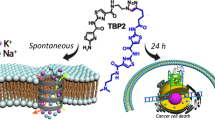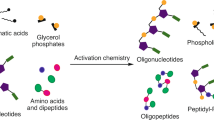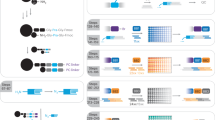Abstract
In nature, ion channels facilitate the transport of ions across biological membranes. The development of artificial ion channels that can mimic the fundamental functions of the natural ones would be of great importance to biological research. Artificial ion channels based on nucleoside derivatives are expected to be biocompatible with functions that can be controlled by the presence or absence of biologically relevant molecules. This protocol describes the detailed procedures for the synthesis and ion-channel activity of four diguanosine derivatives, each made up of two guanosine moieties separated by a covalent linker (e.g., PEG). The procedure describes the preparation of guanosine azide and guanosine alkine building blocks, as well as the preparation of four distinct synthetic linkers each containing either two alkynes or two azides. The diguanosine derivatives are synthesized using a 'one-pot' modular synthetic approach based on Cu(I)-catalyzed azide and alkyne cycloaddition. The ion-channel activity of these diguanosine derivatives for the transportation of ions across a phospholipid bilayer is investigated using voltage-clamp experiment. By using the PEG-containing diguanosine as an example, we describe how to determine the ion-channel activity in the presence of different metal ions (e.g., Na+, K+ and Cs+) and the inhibition of the ion-channel activity using the nucleobase cytosine. The approximate time frame for the synthesis of the PEG dinucleoside is 3 d, and that for the experiments to evaluate its ability to transport K+ ion across a phospholipid bilayer is ∼8–10 h.
This is a preview of subscription content, access via your institution
Access options
Subscribe to this journal
Receive 12 print issues and online access
$259.00 per year
only $21.58 per issue
Buy this article
- Purchase on SpringerLink
- Instant access to full article PDF
Prices may be subject to local taxes which are calculated during checkout











Similar content being viewed by others
References
Alberts, B. et al. Molecular Biology of the Cell 5th edn. (Garland Science, 2007).
Hille, B. Ion Channels of Excitable Membranes 3rd edn. (Sinauer Associates, 2001).
Sisson, A.L., Shah, M.R., Bhosale, S. & Matile, S. Synthetic ion channels and pores (2004–2005). Chem. Soc. Rev. 35, 1269–1286 (2006).
Fyles, T.M. Synthetic ion channels in bilayer membranes. Chem. Soc. Rev. 36, 335–347 (2007).
Chui, J.K.W. & Fyles, T.M. Ionic conductance of synthetic channels: analysis, lessons, and recommendations. Chem. Soc. Rev. 41, 148–175 (2012).
Gokel, G.W. & Carasel, I.A. Biologically active, synthetic ion transporters. Chem. Soc. Rev. 36, 378–389 (2007).
Szyman´ski, W., Beierle, J.M., Kistemaker, H.A.V., Velema, W.A. & Feringa, B.L. Reversible photocontrol of biological systems by the incorporation of molecular photoswitches. Chem. Rev. 113, 6114–6178 (2013).
Itoh, H. & Inoue, M. Chemical construction and structural permutation of potent cytotoxin polytheonamide B: discovery of artificial peptides with distinct functions. Acc. Chem. Res. 46, 1567–1578 (2013).
Otis, F., Auger, M. & Voyer, N. Exploiting peptide nanostructures to construct functional artificial ion channels. Acc. Chem. Res. 46, 2934–2943 (2013).
Fyles, T.M. How do amphiphiles form ion-conducting channels in membranes? Lessons from linear oligoesters. Acc. Chem. Res. 46, 2847–2855 (2013).
Gokel, G.W. & Negin, S. Synthetic ion channels: from pores to biological applications. Acc. Chem. Res. 46, 2824–2833 (2013).
Gong, B. & Shao, Z. Self-assembling organic nanotubes with precisely defined, sub-nanometer pores: formation and mass transport characteristics. Acc. Chem. Res. 46, 2856–2866 (2013).
Sakai, N., Mareda, J. & Matile, S. Ion channels and pores, made from scratch. Mol. Biosyst. 3, 658–666 (2007).
Sakai, N. et al. Dendritic folate rosettes as ion channels in lipid bilayers. J. Am. Chem. Soc. 128, 2218–2219 (2006).
Kaucher, M.S., Harrell, W.A. Jr. & Davis, J.T. A unimolecular G-quadruplex that functions as a synthetic transmembrane Na+ transporter. J. Am. Chem. Soc. 128, 38–39 (2006).
Ma, L., Melegari, M., Colombini, M. & Davis, J.T. Large and stable transmembrane pores from guanosine-bile acid conjugates. J. Am. Chem. Soc. 130, 2938–2939 (2008).
Ma, L., Harrell, W.A. Jr. & Davis, J.T. Stabilizing guanosine-sterol ion channels with a carbamate to urea modification in the linker. Org. Lett. 11, 1599–1602 (2009).
Kumar, Y.P. et al. Triazole-tailored guanosine dinucleosides as biomimetic ion channels to modulate transmembrane potential. Chemistry 20, 3023–3028 (2014).
Das, R.N., Kumar, Y.P., Schütte, O.M., Steinem, C. & Dash, J.A. DNA-inspired synthetic ion channel based on G-C base pairing. J. Am. Chem. Soc. 137, 34–37 (2015).
Langecker, M. et al. Synthetic lipid membrane channels formed by designed DNA nanostructures. Science 338, 932–936 (2012).
Bayley, H. & Jayasinghe, L. Functional engineered channels and pores. Mol. Membr. Biol. 21, 209–220 (2004).
Davis, J.T. & Spada, G.P. Supramolecular architectures generated by self-assembly of guanosine derivatives. Chem. Soc. Rev. 36, 296–313 (2007).
Pieraccini, S. et al. Solvent-induced switching between two supramolecular assemblies of a guanosine-terthiophene conjugate. Org. Biomol. Chem. 8, 774–781 (2010).
Simeone, L. et al. Design, synthesis and characterization of guanosine-based amphiphiles. Chemistry 17, 13854–13865 (2011).
Lena, S., Neviani, P., Masiero, S., Pieraccini, S. & Spada, G.P. Triggering of guanosine self-assembly by light. Angew. Chem. Int. Ed. 49, 3657–3660 (2010).
Lena, S. et al. Self-assembly of an alkylated guanosine derivative into ordered supramolecular nanoribbons in solution and on solid surfaces. Chemistry 13, 3757–3764 (2007).
Li, Y. et al. Influence of tunable external stimuli on the self-assembly of guanosine supramolecular nanostructures studied by atomic force microscope. Langmuir 25, 13432–13437 (2009).
Arnal-Hrault, C. et al. Functional G-quartet macroscopic membrane films. Angew. Chem. Int. Ed. 46, 8409–8413 (2007).
Sreenivasachary, N. & Lehn, J.M. Structural selection in G-quartet-based hydrogels and controlled release of bioactive molecules. Chem. Asian J. 3, 134–139 (2008).
Das, R.N., Kumar, Y.P., Pagoti, S., Patil, A.J. & Dash, J. Diffusion and birefringence of bioactive dyes in a guanosine supramolecular hydrogel. Chemistry 18, 6008–6014 (2012).
Buerkle, L.E., von Recum, H.A. & Rowan, S.J. Toward potential supramolecular tissue engineering scaffolds based on guanosine derivatives. Chem. Sci. 3, 564–572 (2012).
Peters, G.M. et al. A G4·K+ hydrogel stabilized by an anion. J. Am. Chem. Soc. 136, 12596–12599 (2014).
Peters, G.M. et al. G4-quartet·M(+) borate hydrogels. J. Am. Chem. Soc. 137, 5819–5827 (2015).
Balasubramanian, S., Hurley, L.H. & Neidle, S. Targeting G-quadruplexes in gene promoters: a novel anticancer strategy? Nat. Rev. Drug Discov. 10, 261–275 (2011).
Collie, G.W. & Parkinson, G.N. The application of DNA and RNA G-quadruplexes to therapeutic medicines. Chem. Soc. Rev. 40, 5867–5892 (2011).
Zhang, B., Cui, Z. & Sun, L. Synthesis of 5′-deoxy-5′-thioguanosine- 5′-monophosphorothioate and its incorporation into RNA 5′-termini. Org. Lett. 3, 275–278 (2001).
Likhitsup, A., Yu, S., Ng, Y.H., Chai, C.L.L. & Tam, E.K.W. Controlled polymerization and self-assembly of a supramolecular star polymer with a guanosine quadruplex core. Chem. Commun. 4070–4072 (2009).
Daz, D.D., Rajagopal, K., Strable, E., Schneider, J. & Finn, M.G. 'Click' chemistry in a supramolecular environment: stabilization of organogels by copper (I)-catalyzed azide-alkyne [3 + 2] cycloaddition. J. Am. Chem. Soc. 128, 6056–6057 (2006).
Eissa, A.M. & Khosravi, E. Synthesis of a new smart temperature responsive glycopolymer via click-polymerisation. Eur. Polym. J. 47, 61–69 (2011).
Thomas, J.R., Liu, X. & Hergenrother, P.J. Size-specific ligands for RNA hairpin loops. J. Am. Chem. Soc. 127, 12434–12435 (2005).
Rostovtsev, V.V., Green, L.G., Fokin, V.V. & Sharpless, K.B. A stepwise Huisgen cycloaddition process: copper (I)-catalyzed regioselective 'ligation' of azides and terminal alkynes. Angew. Chem. Int. Ed. 41, 2596–2599 (2002).
Kurz, A. et al. Lipid-anchored oligonucleotides for stable double-helix formation in distinct membrane domains. Angew. Chem. Int. Ed. 45, 4440–4444 (2006).
Mathivet, L., Cribier, S. & Devaux, P.F. Shape change and physical properties of giant phospholipid vesicles prepared in the presence of an AC electric field. Biophys. J. 70, 1112–1121 (1996).
Angelova, M.I. & Dimitrov, D.S. Liposome electroformation. Faraday Discuss. Chem. Soc. 81, 303–311 (1986).
Itoh, H., Matsuoka, S., Kreir, M. & Inoue, M. Design, synthesis and functional analysis of dansylated polytheonamide mimic: an artificial peptide ion channel. J. Am. Chem. Soc. 134, 14011–14018 (2012).
Coppola, C. et al. Design, synthesis and characterisation of a fluorescently labelled CyPLOS ionophore. Chemistry 16, 13757–13772 (2010).
You, L. & Gokel, G.W. Fluorescent, synthetic amphiphilic heptapeptide anion transporters: evidence for self-assembly and membrane localization in liposomes. Chem. Eur. J. 14, 5861–5870 (2008).
Andersson, M. et al. Detection of single ion channel activity on a chip using tethered bilayer membranes. Langmuir 23, 2924–2927 (2007).
Krause, M.R. & Regen, S.L. The structural role of cholesterol in cell membranes: from condensed bilayers to lipid rafts. Acc. Chem. Res. 47, 3512–3521 (2014).
Hahn, F.E., Langenhahn, V. & Pape, T. Template synthesis of tungsten complexes with saturated N-heterocyclic carbene ligands. Chem. Commun. 5390–5392 (2005).
Acknowledgements
This work was supported by the Board of Research in Nuclear Sciences (BNRS), Department of Atomic Energy (DAE) and Department of Biotechnology (DBT) India. The DFG (SFB 803, project A01) is gratefully acknowledged. Y.P.K. and R.N.D. thank Council of Scientific and Industrial Research (CSIR), India, and R.N.D. thanks the Deutscher Akademischer Austauschdienst (DAAD) Exchange Programme for a research fellowship.
Author information
Authors and Affiliations
Contributions
J.D. and C.S. designed the experiments; Y.P.K. synthesized the compounds; R.N.D. and O.M.S. carried out the voltage-clamp experiments; and J.D. wrote the paper with the input from all the authors.
Corresponding authors
Ethics declarations
Competing interests
The authors declare no competing financial interests.
Rights and permissions
About this article
Cite this article
Kumar, Y., Das, R., Schütte, O. et al. Bis-triazolyl diguanosine derivatives as synthetic transmembrane ion channels. Nat Protoc 11, 1039–1056 (2016). https://doi.org/10.1038/nprot.2016.045
Published:
Issue date:
DOI: https://doi.org/10.1038/nprot.2016.045
This article is cited by
-
Applications of guanine quartets in nanotechnology and chemical biology
Nature Reviews Chemistry (2019)



